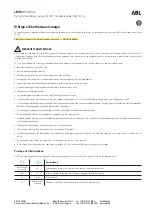
WARNING!
and rolling the vehicle, which may result in severe injury.
Always back carefully straight down a hill in REVERSE.
Never back down a hill in NEUTRAL using only the
vehicle brakes. Never drive diagonally across a hill,
always drive straight up or down.
Driving Through Water
Extreme care should be taken crossing any type of water.
Water crossings should be avoided, if possible, and only
be attempted when necessary in a safe, responsible man-
ner. Only drive through areas which are designated and
approved. Tread lightly and avoid damage to the environ-
ment. Know your vehicle's abilities and be able to recover
it if something goes wrong. Never stop or shut a vehicle
off when crossing deep water unless you ingested water
into the engine air intake. If the engine stalls, do not
attempt to restart it. Determine if it has ingested water
first. The key to any crossing is low and slow. Shift into
FIRST gear (manual transmission), or DRIVE (automatic
transmission), with the transfer case in the 4L position
and proceed very slowly with a constant slow speed of
{3 to 5 mph (5 to 8 km/h) maximum} and light throttle.
Keep the vehicle moving; do not try to accelerate through
the crossing. After crossing any water higher than the bot-
tom of the axle differentials, inspect all of the vehicle flu-
ids for signs of water ingestion.
CAUTION!
•
Water ingestion into the axles, transmission, trans-
fer case, engine or vehicle interior can occur if you
drive too fast or through too deep of water.
(Continued)
CAUTION!
Water can cause permanent damage to engine,
driveline or other vehicle components, and your
brakes will be less effective once wet and/or muddy.
•
When driving through water, do not exceed 5 mph
(8 km/h). Always check water depth before entering
as a precaution, and check all fluids afterward. Driv-
ing through water may cause damage that may not
be covered by the New Vehicle Limited Warranty.
BEFORE YOU CROSS ANY TYPE OF WATER
As you approach any type of water, you need to deter-
mine if you can cross it safely and responsibly. If neces-
sary, get out and walk through the water or probe it with
a stick. You need to be sure of its depth, approach
angle, current and bottom condition. Be careful of
murky or muddy waters; check for hidden obstacles.
Make sure you will not be intruding on any wildlife, and
you can recover the vehicle if necessary. The key to a
safe crossing is the water depth, current and bottom
conditions. On soft bottoms, the vehicle will sink in,
effectively increasing the water level on the vehicle. Be
sure to consider this when determining the depth and
the ability to safely cross.
CROSSING PUDDLES, POOLS, FLOODED
AREAS OR OTHER STANDING WATER
Puddles, pools, flooded or other standing water areas nor-
mally contain murky or muddy waters. These water types
normally contain hidden obstacles and make it difficult to
determine an accurate water depth, approach angle, and
bottom condition. Murky or muddy water holes are where
you want to hook up tow straps prior to entering. This
makes for a faster, cleaner and easier vehicle recovery. If
you are able to determine you can safely cross, than pro-
ceed using the low and slow method.
CAUTION!
Muddy waters can reduce the cooling system effec-
tiveness by depositing debris onto the radiator.
CROSSING DITCHES, STREAMS, SHALLOW
RIVERS OR OTHER FLOWING WATER
Flowing water can be extremely dangerous. Never attempt
to cross a fast running stream or river even in shallow
water. Fast moving water can easily push your vehicle
downstream, sweeping it out of control. Even in very shal-
low water, a high current can still wash the dirt out from
around your tires putting you and your vehicle in jeopardy.
There is still a high risk of personal injury and vehicle
damage with slower water currents in depths greater than
the vehicle's running ground clearance. You should never
attempt to cross flowing water which is deeper than the
vehicle's running ground clearance. Even the slowest cur-
rent can push the heaviest vehicle downstream and out of
control if the water is deep enough to push on the large
surface area of the vehicle's body. Before you proceed,
determine the speed of the current, the water's depth,
approach angle, bottom condition and if there are any
obstacles. Then cross at an angle heading slightly
upstream using the low and slow technique.
WARNING!
Never drive through fast moving deep water. It can
push your vehicle downstream, sweeping it out of
control. This could put you and your passengers at
risk of injury or drowning.
STARTING AND OPERATING
199
4
5538906_24_JL_OM_EN_USC_t_E1.pdf 199
5/22/2023 9:02:25 AM
















































